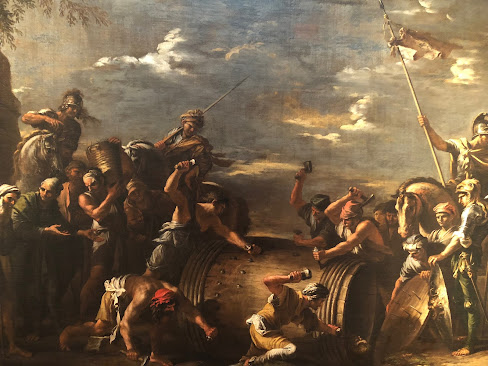Welcome to one of the most cheerfully horrifying moral paintings ever to grace a canvas: The Death of Regulus, Salvator Rosa’s baroque fever dream of spikes, senators, and sheer masochistic Roman virtue. In it, Rosa captures not the death of the Roman general Marcus Atilius Regulus per se, but the long, spiky prelude, a team of laborers meticulously nailing a torture barrel shut like they’re assembling IKEA’s “Painståkig” model. Regulus himself? He’s either offstage or already inside, contemplating civic duty and wishing Carthage had a better HR department.
The real star is the barrel, a rolling wood-and-metal philosophy dissertation on Stoicism, state cruelty, and the cost of being that guy in the Senate who says, “I gave my word.” Around it, we get the moral Greek chorus: soldiers stoic as statues, civilians wringing hands, and torturers who look like they’re on hour six of a deeply unpleasant team-building exercise. The whole affair feels like a Roman version of a corporate offsite, if the theme were integrity through agony, and the dress code included togas and wrist manacles.
Salvator Rosa, Patron Saint of Beautiful Defiance
Salvator Rosa (1615–1673) was what happens when you cross a battle painter with a theater kid and a moral philosopher. A Neapolitan by birth and temperament, he spent much of his life pushing back against the academic drudgery of classicism. While other painters turned out cherubs and allegories with the polish of a courtly dance, Rosa gave us witches, bandits, martyrs, and death by artisanal carpentry. He was a self-styled outsider, equal parts artistic maverick and existential rage poet with a brush.
Rosa wasn’t just interested in painting bodies; he wanted to paint ideas. And not the soft ones. His works are political pamphlets in oil, bristling with suspicion toward authority, sympathy for the virtuous damned, and disdain for the well-fed elite. He wasn’t so much painting for popes and patrons as he was screaming across time, “You think I’m intense? Wait till you meet Regulus.”
Rome’s Favorite Martyr and Carthage’s PR Problem
The story of Regulus is the kind of Roman fable you’d get if Cicero wrote for HBO. A consul captured in the First Punic War, Regulus is sent back to Rome by his Carthaginian captors to negotiate peace. Instead, he urges the Senate not to settle, returns to captivity out of principle, and is then executed in a way that reads like a deleted scene from Saw III. The whole spiked barrel narrative was almost certainly a later invention, but hey, never let the truth get in the way of a story that says, “Rome: Come for the roads, stay for the martyrdom.”
By the time Rosa gets his hands on this myth, Regulus isn’t just a character; he’s a symbol. A stoic icon. A pin-up for honor-through-pain, drawn in oil and sharpened with 17th-century political cynicism. The painting reflects not just ancient cruelty, but also modern parallels that Rosa saw in the groveling hypocrisy of courts, popes, and princes. Regulus wasn’t just dead, he was weaponized, an ancient hero conscripted to shame modern cowards.
Glory in a Barrel, or Just the Worst Hot Tub Ever?
So, what does The Death of Regulus mean? It’s simple, really. Stand for your principles, and the world will reward you with a barrel full of spikes and exactly zero sympathy. It’s about civic virtue stretched on the rack of political expedience, about noble self-sacrifice being seen but not saved. Rosa’s message? Rome remembers its martyrs only after they’re dead, and so will you.
And let’s be honest: if Rosa were alive today, he’d be painting this scene on a wall across from a government building, with Regulus replaced by a whistleblower and the barrel painted like a budget spreadsheet.
Would you go back to Carthage… if you knew the exit interview involved nails and a barrel and not even so much as a fruit basket?
#RomanMartyrdom #SalvatorRosa #DeathByVirtue #RegulusGotRolled #BarrelOfEthics #CarthaginianHR #DutyIsPainful #BaroqueAndUnfiltered #ArtHistoryBurns #MuseumOfMoralDespair #HotTubOfHell #OilOnCanvasAndOnNails





No comments:
Post a Comment